REDD+ in West Africa: Politics of Design and Implementation in Ghana and Nigeria
Abstract
:1. Introduction
2. Materials and Methods
3. Results
3.1. Politics of Design
3.2. Politics of Implementation (UNREDD, United Nations-REDD Project; FCPF, Forest Carbon Partnership Facility)
3.2.1. Capacity Building
3.2.2. Visualising Carbon
3.2.3. Defining Property Rights
4. Discussion and Conclusions
Acknowledgments
Author Contributions
Conflicts of Interest
References
- United Nations. Transforming Our World: The 2030 Agenda for Sustainable Development; Resolution Adopted by the General Assembly on 25 September 2015; United Nations: New York, NY, USA, 2005. [Google Scholar]
- Gunilla, E.; Olsson, A.; Ouattara, S. Opportunities and challenges to capturing the multiple potential benefits of REDD+ in a traditional transnational savanna-woodland region in west Africa. Ambio 2013, 42, 309–319. [Google Scholar]
- Arhin, A.; Atela, J. Forest carbon projects and policies in Africa. In Carbon Conflicts and Forest Landscapes in Africa; Routledge: London, UK, 2015; p. 43. [Google Scholar]
- Cerbu, G.A.; Swallow, B.M.; Thompson, D.Y. Locating REDD: A global survey and analysis of REDD readiness and demonstration activities. Environ. Sci. Policy 2011, 14, 168–180. [Google Scholar] [CrossRef]
- National Forest Policy. National Forest Policy, The Federal Ministry of Environment Abuja. 2006. Available online: http://www.fao.org/forestry/15148–0c4acebeb8e7e45af360ec63fcc4c1678.pdf (accessed on 6 May 2014).
- Myers, N.; Mittermeier, R.A.; Mittermeier, C.G.; Da Fonseca, G.A.; Kent, J. Biodiversity hotspots for conservation priorities. Nature 2000, 403, 853–858. [Google Scholar] [CrossRef] [PubMed]
- Fairhead, J.; Leach, M. Misreading the African Landscape: Society and Ecology in a Forest-Savanna Mosaic; Cambridge University Press: Cambridge, UK, 1996; Volume 90. [Google Scholar]
- Okali, D.; Eyog-Matig, O. Rain Forest Management for Wood Production in West and Central Africa; A Report Prepared for the Project Lessons Learnt on Sustainable Forest Management in Africa for The African Forest Research Network (AFORNET), Nairobi, Kenya; The Royal Swedish Academy of Agriculture and Forestry (KSLA): Stockholm, Sweden; The Food and Agriculture Organisation of United Nations (FAO): Rome, Italy, 2004. [Google Scholar]
- Leach, M.; Mearns, R. The Lie of the Land: Challenging Received Wisdom on the African Environment; International African Institute in Association with James Currey Ltd.: London, UK, 1996. [Google Scholar]
- Cline Cole, R.; Madge, C. Contesting Forestry in West Africa; Ashgate: Farnham, UK, 2000. [Google Scholar]
- Hochschild, A. King Leopold’s Ghost: A Story of Greed, Terror, and Heroism in Colonial Africa; Houghton Mifflin Harcourt: Boston, MA, USA, 1999. [Google Scholar]
- Grove, R.; Falola, T. Chiefs, boundaries, and sacred woodlands: Early nationalism and the defeat of colonial conservationism in the gold coast and Nigeria, 1870–1916. Afr. Econ. Hist. 1996, 24, 1–23. [Google Scholar] [CrossRef]
- Schroeder, R.A. Community, forestry and conditionality in the Gambia. Africa 1999, 69, 1–22. [Google Scholar] [CrossRef]
- Amanor, K.S. The new frontier: Farmers’ response to land degradation—A west African study. In Revisiting Sustainable Development; United Nations Research Institute for Social Development (UNRISD): Geneva, Switzerland, 1994; Volume 159. [Google Scholar]
- Leach, M.; Mearns, R.; Scoones, I. Environmental entitlements: Dynamics and institutions in community-based natural resource management. World Dev. 1999, 27, 225–247. [Google Scholar] [CrossRef]
- Robbins, P. Political Ecology: A Critical Introduction; John Wiley & Sons: Sussex, UK, 2011; Volume 16. [Google Scholar]
- Death, C. Critical Environmental Politics; Routledge: Oxon, UK; New York, NY, USA, 2014. [Google Scholar]
- Bryant, R.L. The International Handbook of Political Ecology; Edward Elgar Publishing: Cheltenham, UK, 2015. [Google Scholar]
- Fairhead, J.; Leach, M. Reframing Deforestation: Global Analyses and Local Realities with Studies in West Africa; Psychology Press: London, UK, 1998. [Google Scholar]
- Corbera, E. Problematizing REDD+ as an experiment in payments for ecosystem services. Curr. Opin. Environ. Sustain. 2012, 4, 612–619. [Google Scholar] [CrossRef]
- McGregor, A.; Challies, E.; Howson, P.; Astuti, R.; Dixon, R.; Haalboom, B.; Gavin, M.; Tacconi, L.; Afiff, S. Beyond carbon, more than forest? REDD+ governmentality in Indonesia. Environ. Plan. A 2015, 47, 138–155. [Google Scholar] [CrossRef]
- Visseren-Hamakers, I.J.; McDermott, C.; Vijge, M.J.; Cashore, B. Trade-offs, co-benefits and safeguards: Current debates on the breadth of REDD+. Curr. Opin. Environ. Sustain. 2012, 4, 646–653. [Google Scholar] [CrossRef]
- Phelps, J.; Friess, D.; Webb, E. Win–win REDD+ approaches belie carbon–biodiversity trade-offs. Biol. Conserv. 2012, 154, 53–60. [Google Scholar] [CrossRef]
- Leach, M.; Scoones, I. Carbon forestry in west Africa: The politics of models, measures and verification processes. Glob. Environ. Chang. 2013, 23, 957–967. [Google Scholar] [CrossRef] [Green Version]
- Leach, M.; Scoones, I. Carbon Conflicts and Forest Landscapes in Africa; Routledge: Oxon, UK; New York, NY, USA, 2015. [Google Scholar]
- Nel, A.; Hill, D. Constructing walls of carbon–the complexities of community, carbon sequestration and protected areas in Uganda. J. Contemp. Afr. Stud. 2013, 31, 421–440. [Google Scholar] [CrossRef]
- Gupta, A.; Lövbrand, E.; Turnhout, E.; Vijge, M.J. In pursuit of carbon accountability: The politics of REDD+ measuring, reporting and verification systems. Curr. Opin. Environ. Sustain. 2012, 4, 726–731. [Google Scholar] [CrossRef]
- Cavanagh, C.J.; Vedeld, P.O.; Trædal, L.T. Securitizing REDD+? Problematizing the emerging illegal timber trade and forest carbon interface in east Africa. Geoforum 2015, 60, 72–82. [Google Scholar] [CrossRef]
- Asiyanbi, A.P. A political ecology of REDD+: Property rights, militarised protectionism, and carbonised exclusion in cross river. Geoforum 2016, 77, 146–156. [Google Scholar] [CrossRef]
- Beymer-Farris, B.A.; Bassett, T.J. The REDD menace: Resurgent protectionism in Tanzania’s mangrove forests. Glob. Environ. Chang. 2012, 22, 332–341. [Google Scholar] [CrossRef]
- McAfee, K. The contradictory logic of global ecosystem services markets. Dev. Chang. 2012, 43, 105–131. [Google Scholar] [CrossRef]
- Cavanagh, C.; Benjaminsen, T.A. Virtual nature, violent accumulation: The ‘spectacular failure’of carbon offsetting at a ugandan national park. Geoforum 2014, 56, 55–65. [Google Scholar] [CrossRef]
- Asiyanbi, A. Mind the gap: Global truths, local complexities in emergent green initiatives. In The International Handbook of Political Ecology; Edward Elgar Publishing: Cheltenham, UK, 2015; Volume 274. [Google Scholar]
- Büscher, B. Transforming the Frontier: Peace Parks and the Politics of Neoliberal Conservation in Southern Africa; Duke University Press: Durham, UK, 2013. [Google Scholar]
- Büscher, B.; Dressler, W.; Fletcher, R. Nature Inc.: Environmental Conservation in the Neoliberal Age; University of Arizona Press: Tucson, AZ, USA, 2014. [Google Scholar]
- Fletcher, R. How I learned to stop worrying and love the market: Virtualism, disavowal, and public secrecy in neoliberal environmental conservation. Environ. Plan. D Soc. Space 2013, 31, 796–812. [Google Scholar] [CrossRef]
- Lund, J.F.; Sungusia, E.; Mabele, M.B.; Scheba, A. Promising change, delivering continuity: REDD+ as conservation fad. World Dev. 2017, 89, 124–139. [Google Scholar] [CrossRef]
- Fletcher, R.; Dressler, W.; Büscher, B.; Anderson, Z.R. Questioning REDD+ and the future of market-based conservation. Conserv. Biol. 2016, 30, 673–675. [Google Scholar] [CrossRef] [PubMed]
- Špirić, J.; Corbera, E.; Reyes-García, V.; Porter-Bolland, L. Uncovering REDD+ readiness in Mexico; Universitat Autònoma de Barcelona: Bellaterra, Spain, 2016. [Google Scholar]
- Lohmann, L. Carbon trading, climate justice and the production of ignorance: Ten examples. Development 2008, 51, 359–365. [Google Scholar] [CrossRef]
- Bastakoti, R.R.; Davidsen, C. Nepal’s REDD+ readiness preparation and multi-stakeholder consultation challenges. J. For. Livelihood 2016, 13, 30–43. [Google Scholar] [CrossRef]
- Arhin, A.A. Safeguards and dangerguards: A framework for unpacking the black box of safeguards for REDD+. For. Policy Econ. 2014, 45, 24–31. [Google Scholar] [CrossRef]
- McDermott, C.L.; Coad, L.; Helfgott, A.; Schroeder, H. Operationalizing social safeguards in REDD+: Actors, interests and ideas. Environ. Sci. Policy 2012, 21, 63–72. [Google Scholar] [CrossRef]
- Nuesiri, E. Local government authority and representation in REDD+: A case study from Nigeria. Int. For. Rev. 2016, 18, 306–318. [Google Scholar] [CrossRef]
- Thompson, M.C.; Baruah, M.; Carr, E.R. Seeing REDD+ as a project of environmental governance. Environ. Sci. Policy 2011, 14, 100–110. [Google Scholar] [CrossRef]
- Leach, M.; Fairhead, J.; Fraser, J. Green grabs and biochar: Revaluing African soils and farming in the new carbon economy. J. Peasant Stud. 2012, 39, 285–307. [Google Scholar] [CrossRef] [Green Version]
- Lyons, K.; Westoby, P. Carbon colonialism and the new land grab: Plantation forestry in Uganda and its livelihood impacts. J. Rural Stud. 2014, 36, 13–21. [Google Scholar] [CrossRef]
- Kothari, C.R. Research Methodology: Methods and Techniques; New Age International: New Delhi, India, 2004. [Google Scholar]
- Creswell, J.W. Research Design: Qualitative, Quantitative, and Mixed Methods Approaches; Sage Publications: Thousand Oaks, CA, USA, 2013. [Google Scholar]
- Hajer, M.; Versteeg, W. A decade of discourse analysis of environmental politics: Achievements, challenges, perspectives. J. Environ. Policy. Plan. 2005, 7, 175–184. [Google Scholar] [CrossRef]
- Li, T.M. The Will to Improve: Governmentality, Development, and the Practice of Politics; Duke University Press: Durham, UK, 2007. [Google Scholar]
- Strauss, A.; Corbin, J. Basics of Qualitative Research; Sage: Newbury Park, CA, USA, 1990; Volume 15. [Google Scholar]
- Saldaña, J. The Coding Manual for Qualitative Researchers; Sage: Newbury Park, CA, USA, 2015. [Google Scholar]
- Oates, J.F. Myth and Reality in the Rain Forest: How Conservation Strategies Are Failing in West Africa; Univ of California Press: Oakland, CA, USA, 1999. [Google Scholar]
- Abua, S.; Spencer, R.; Spencer, D. Design and outcomes of community forest conservation initiatives in cross river state of Nigeria: A foundation for REDD+? In Conservation Biology: Voices from the Tropics; John Wiley & Sons, Ltd.: Sussex, UK, 2013; pp. 51–58. [Google Scholar]
- Ite, U.; Adams, W. Expectations, impacts and attitudes: Conservation and development in cross river national park, Nigeria. J. Int. Dev. 2000, 12, 325. [Google Scholar] [CrossRef]
- Alashi, S.A. National parks & biodiversity conservation: Problems with participatory forestry management. Rev. Afr. Political Econ. 1999, 26, 140–144. [Google Scholar]
- Stephan, B. How to trade ‘not cutting down trees’. In Interpretive Approaches to Global Climate Governance: (De) constructing the Greenhouse; Routledge: Oxon, UK; New York, NY, USA, 2013; Volume 57. [Google Scholar]
- Paterson, M.; Stripple, J. My space: Governing individuals’ carbon emissions. Environ. Plan. D Soc. Space 2010, 28, 341–362. [Google Scholar] [CrossRef]
- Summit Communiqué. Communiqué If the Stakeholders’ Summit on the Environment 25th–28th June, 2008; Ministry of Environment: Calabar, Nigeria, 2008. [Google Scholar]
- Ghazoul, J.; Butler, R.A.; Mateo-Vega, J.; Koh, L.P. REDD: A reckoning of environment and development implications. Trends Ecol. Evol. 2010, 25, 396–402. [Google Scholar] [CrossRef]
- Land Use Act. Land Use Act, Chapter 202, Laws of the Federation of Nigeria. 1990. Available online: http://www.nigeria-law.org/Land%20Use%20Act.htm (accessed on 20 May 2016).
- National Programme Document: Nigeria (2011). Available online: http://www.unredd.org/AboutUNREDDProgramme/NationalProgrammes/Nigeria/tabid/992/Default.aspx (accessed on 26 May 2014).
- Ghana Forestry Commission. The National REDD+ Strategy (Final Draft). 2015. Available online: https://www.forestcarbonpartnership.org/sites/fcp/files/2015/April/Ghana%20National%20REDD%2B%20Strategy%20Final.pdf (accessed on 9 March 2016).
- Nuesiri, E.O. Representation in REDD: NGOs and Chiefs Privileged over Elected Local Government in Cross River State, Nigeria. RFGI Working Paper No. 11. Available online: https://sdep.earth.illinois.edu/files/RFGI_Working_Papers/11_Emmanuel%20Nuesiri.pdf (accessed on 9 March 2017).
- Kojwang, H.O. Review Synthesis of Nigeria R-PP. 2013. Available online: https://www.forestcarbonpartnership.org/sites/fcp/files/2013/Nigeria%20PC16%20R-PP%20Synthesis%20Review%2015-Nov-2013.pdf (accessed on 9 March 2017).
- Adjei, K.; Asare, R.A. Ghana: Mapping REDD+ Finance Flows 2009–2014. A Forest Trends REDDX Report. Available online: http://forest-trends.org/publication_details.php?publicationID=5030 2016 (accessed on 22 September 2016).
- Romijn, E.; Herold, M.; Kooistra, L.; Murdiyarso, D.; Verchot, L. Assessing capacities of non-annex i countries for national forest monitoring in the context of REDD+. Environ. Sci. Policy 2012, 19, 33–48. [Google Scholar] [CrossRef]
- Angelsen, A. Realising REDD+: National Strategy and Policy Options; Center for International Forestry Research (CIFOR): Bogor, Indonesia, 2009. [Google Scholar]
- Angelsen, A.; Brockhaus, M.; Sunderlin, W.D.; Verchot, L.V. Analysing REDD+: Challenges and Choices; CIFOR: Bogor, Indonesia, 2012. [Google Scholar]
- Biddulph, R. Geographies of Evasion. The Development Industry and Property Rights Interventions in Early 21st Century Cambodia. Ph.D. thesis, University of Gothenburg Series, Gothenburg, Sweden, May 2010. [Google Scholar]
- Sunderlin, W.D.; Larson, A.M.; Duchelle, A.E.; Resosudarmo, I.A.P.; Huynh, T.B.; Awono, A.; Dokken, T. How are REDD+ proponents addressing tenure problems? Evidence from Brazil, Cameroon, Tanzania, Indonesia, and Vietnam. World Dev. 2014, 55, 37–52. [Google Scholar] [CrossRef]
- CRSFC. Annual Report of the Cross River State Forestry Commission; Cross River State Forestry Commission Library: Calabar, Cross River, Nigeria, 2011. [Google Scholar]
- CRSFC. Annual Report of the Cross River State Forestry Commission; Cross River State Forestry Commission Library: Calabar, Cross River, Nigeria, 2012. [Google Scholar]
- Ministry of Lands and Natural Resources (MLNR). Ghana Forest And Wildlife Policy; Ministry of Lands and Natural Resources: Accra, Ghana, 2012.
- Cross River State Government. Pre-Summit Note: Proposed Summary of Cross River State Environmental Agenda and Action Plan: Thematic Areas for Discussion at the Pre-Summit; Cross River State Ministry of Environment: Calabar, Nigeria, 2008; in press.
- Karsenty, A. The world bank’s endeavours to reform the forest concessions’ regime in central Africa: Lessons from 25 years of efforts. Int. For. Rev. 2016, 18, 16. [Google Scholar]
- Fry, B.P. Community forest monitoring in REDD+: The ‘m’in MRV? Environ. Sci. Policy 2011, 14, 181–187. [Google Scholar]
- Danielsen, F.; Skutsch, M.; Burgess, N.D.; Jensen, P.M.; Andrianandrasana, H.; Karky, B.; Lewis, R.; Lovett, J.C.; Massao, J.; Ngaga, Y. At the heart of REDD+: A role for local people in monitoring forests? Conserv. Lett. 2011, 4, 158–167. [Google Scholar] [CrossRef]
- Skutsch, M. Community Forest Monitoring for the Carbon Market: Opportunities under Redd; Earthscan/Routledge: Oxon, UK; New York, NY, USA, 2012. [Google Scholar]
- Larrazábal, A.; McCall, M.K.; Mwampamba, T.H.; Skutsch, M. The role of community carbon monitoring for REDD+: A review of experiences. Curr. Opin. Environ. Sustain. 2012, 4, 707–716. [Google Scholar] [CrossRef]
- Ite, U.E.; Adams, W.M. Forest conversion, conservation and forestry in cross river state, Nigeria. Appl. Geogr. 1998, 18, 301–314. [Google Scholar] [CrossRef]
- Cleaver, F. Development through Bricolage: Rethinking Institutions for Natural Resource Management; Routledge: Oxon, UK, 2012. [Google Scholar]
- De Koning, J.; Cleaver, F. Institutional bricolage in community forestry: An agenda for future research. In Forest-People Interfaces; Wageningen Academic Publishers: Wageningen, The Netherlands, 2012; pp. 277–290. [Google Scholar]
- Cotula, L.; Mayers, J. Tenure in Redd: Start-Point or Afterthought? International Institute for Environment and Development (IIED): London, UK, 2009. [Google Scholar]
- Isyaku, U.; Arhin, A.A.; Asiyanbi, A.P. Framing justice in REDD+ governance: Centring transparency, equity and legitimacy in readiness implementation in West Africa. Environ. Conserv. 2017. [Google Scholar] [CrossRef]
- Marfo, E.; Acheampong, E.; Opuni-Frimpong, E. Fractured tenure, unaccountable authority, and benefit capture: Constraints to improving community benefits under climate change mitigation schemes in Ghana. Conserv. Soc. 2012, 10, 161. [Google Scholar] [CrossRef]
- Karsenty, A.; Vogel, A.; Castell, F. “Carbon rights”, REDD+ and payments for environmental services. Environ. Sci. Policy 2014, 35, 20–29. [Google Scholar] [CrossRef]
- Cross River State Forestry Commission. A Petition to the Cross River State Governor by Agbokim Waterfall Community. Unpublished work, 2011.
- Bryant, R.L. The Political Ecology of Forestry in Burma: 1824–1994; University of Hawaii Press: Honolulu, HI, USA, 1997. [Google Scholar]
- Scott, J.C. Weapons of the Weak: Everyday Forms of Resistance; Yale University Press: New Haven, CT, USA, 1985. [Google Scholar]
- Global Forest Watch. Tree Cover Loss, Cross River Nigeria. 2016. Available online: http://climate.globalforestwatch.org/ (accessed on 23 March 2016).
- Poudel, M.; Thwaites, R.; Race, D.; Dahal, G.R. Social equity and livelihood implications of REDD+ in rural communities–a case study from Nepal. Int. J. Commons 2015, 9, 177–208. [Google Scholar] [CrossRef]
- Karsenty, A.; Ongolo, S. Can “fragile states” decide to reduce their deforestation? The inappropriate use of the theory of incentives with respect to the redd mechanism. For. Policy Econ. 2012, 18, 38–45. [Google Scholar] [CrossRef]
- Yin, R.; Zulu, L.; Qi, J.; Freudenberger, M.; Sommerville, M. Empirical linkages between devolved tenure systems and forest conditions: Primary evidence. For. Policy Econ. 2016, 73, 277–285. [Google Scholar] [CrossRef]
- Burgess, N.D.; Bahane, B.; Clairs, T.; Danielsen, F.; Dalsgaard, S.; Funder, M.; Hagelberg, N.; Harrison, P.; Haule, C.; Kabalimu, K. Getting ready for REDD+ in Tanzania: A case study of progress and challenges. Oryx 2010, 44, 339–351. [Google Scholar] [CrossRef]
- Tienhaara, K. The potential perils of forest carbon contracts for developing countries: Cases from Africa. J. Peasant Stud. 2012, 39, 551–572. [Google Scholar] [CrossRef]
- Putz, F.E.; Redford, K.H. The importance of defining ‘forest’: Tropical forest degradation, deforestation, long-term phase shifts, and further transitions. Biotropica 2010, 42, 10–20. [Google Scholar] [CrossRef]
- Scott, C.T. Sampling methods for estimating change in forest resources. Ecol. Appl. 1998, 8, 228–233. [Google Scholar] [CrossRef]
- McAfee, K.; Shapiro, E.N. Payments for ecosystem services in Mexico: Nature, neoliberalism, social movements, and the state. Ann. Assoc. Am. Geogr. 2010, 100, 579–599. [Google Scholar] [CrossRef]
- Resosudarmo, I.A.P.; Atmadja, S.; Ekaputri, A.D.; Intarini, D.Y.; Indriatmoko, Y.; Astri, P. Does tenure security lead to REDD+ project effectiveness? Reflections from five emerging sites in Indonesia. World Dev. 2014, 55, 68–83. [Google Scholar] [CrossRef]
- Sunderlin, W.D.; Ekaputri, A.D.; Sills, E.O.; Duchelle, A.E.; Kweka, D.; Diprose, R.; Doggart, N.; Ball, S.; Lima, R.; Enright, A. The Challenge of Establishing REDD+ on the Ground: Insights from 23 Subnational Initiatives in Six Countries; Center for International Forestry Research (CIFOR): Bogor, Indonesia, 2014; Volume 104. [Google Scholar]
- Hoare, A.L. Community-Based Forest Management In the Democratic Republic of Congo a Fairytale or a Viable Redd Strategy; Forest Monitor: Cambridge, UK, 2010. [Google Scholar]
- Dulal, H.B.; Shah, K.U.; Sapkota, C. Reducing emissions from deforestation and forest degradation (REDD) projects: Lessons for future policy design and implementation. Int. J. Sustain. Dev. World Ecol. 2012, 19, 116–129. [Google Scholar] [CrossRef]
- Fobissie, K.; Alemagi, D.; Minang, P.A. REDD+ policy approaches in the Congo basin: A comparative analysis of cameroon and the democratic republic of congo (DRC). Forests 2014, 5, 2400–2424. [Google Scholar] [CrossRef]
- Larson, A.M.; Brockhaus, M.; Sunderlin, W.D.; Duchelle, A.; Babon, A.; Dokken, T.; Pham, T.T.; Resosudarmo, I.A.P.; Selaya, G.; Awono, A.; et al. Land tenure and REDD+: The good, the bad and the ugly. Glob. Environ. Chang. 2013, 23, 678–689. [Google Scholar] [CrossRef]
- Larson, A.M.; Brockhaus, M.; Sunderlin, W.D.; Duchelle, A.; Babon, A.; Dokken, T.; Pham, T.T.; Resosudarmo, I.; Selaya, G.; Awono, A. Land tenure and REDD+: The good, the bad and the ugly. Glob. Environ. Chang. 2013, 23, 678–689. [Google Scholar] [CrossRef]
- Bolin, A.; Lawrence, L.; Leggett, M. Land Tenure and Fast-Tracking REDD+: Time to Reframe the Debate? Analytical Paper; Global Canopy Programme: Oxford, UK, 2013. [Google Scholar]
- Tollefson, J. International media spotlight on the amazon roams, but rarely enlightens. Elem. Sci. Anthr. 2015, 3, 58. [Google Scholar] [CrossRef]
- Baroudy Ellysar. Foreword for Forest Carbon Partnership Facility Annual Report; World Bank: Washington, DC, USA, 2015. [Google Scholar]
- Turnhout, E.; Gupta, A.; Weatherley-Singh, J.; Vijge, M.J.; De Koning, J.; Visseren-Hamakers, I.J.; Herold, M.; Lederer, M. Envisioning REDD+ in a post-Paris era: between evolving expectations and current practice. Wiley Interdiscip. Rev. Clim. Chang. 2016. [Google Scholar] [CrossRef]
- Schroeder, H.; McDermott, C. Beyond carbon: Enabling justice and equity in REDD+ across levels of governance. Ecol. Soc. 2014, 19, 31. [Google Scholar] [CrossRef]
- Goldman, M. Imperial Nature: The World Bank and Struggles for Social Justice in the Age of Globalization; Yale University Press: New Haven, CT, USA, 2006. [Google Scholar]
- Ferguson, J. Global Shadows: Africa in the Neoliberal World Order; Duke University Press: Durham, NC, USA, 2006. [Google Scholar]
- Phelps, J.; Webb, E.L.; Agrawal, A. Does REDD+ threaten to recentralize forest governance. Science 2010, 328, 312–313. [Google Scholar] [CrossRef] [PubMed]
- Sandbrook, C.; Nelson, F.; Adams, W.M.; Agrawal, A. Carbon, forests and the redd paradox. Oryx 2010, 44, 330–334. [Google Scholar] [CrossRef]
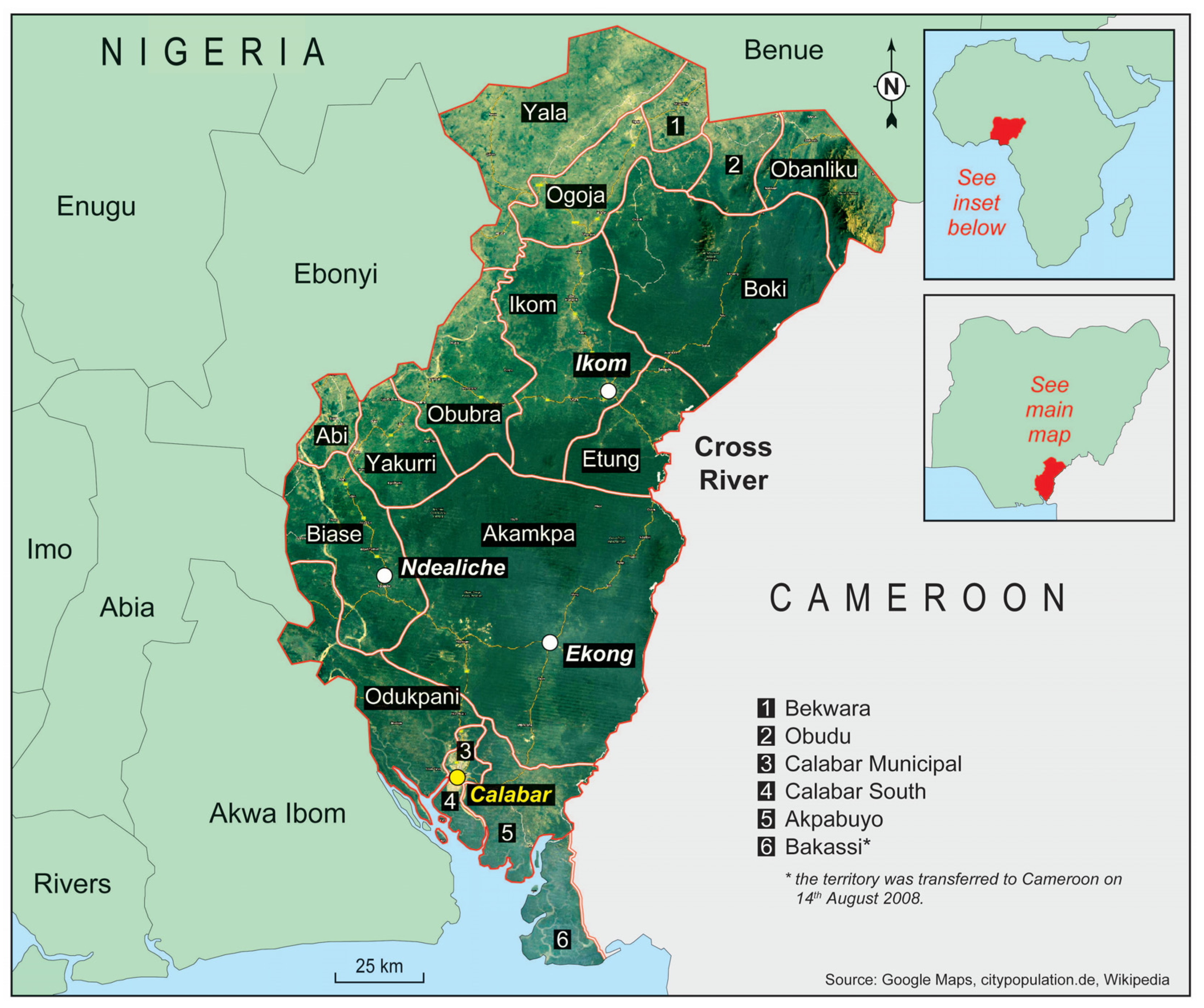
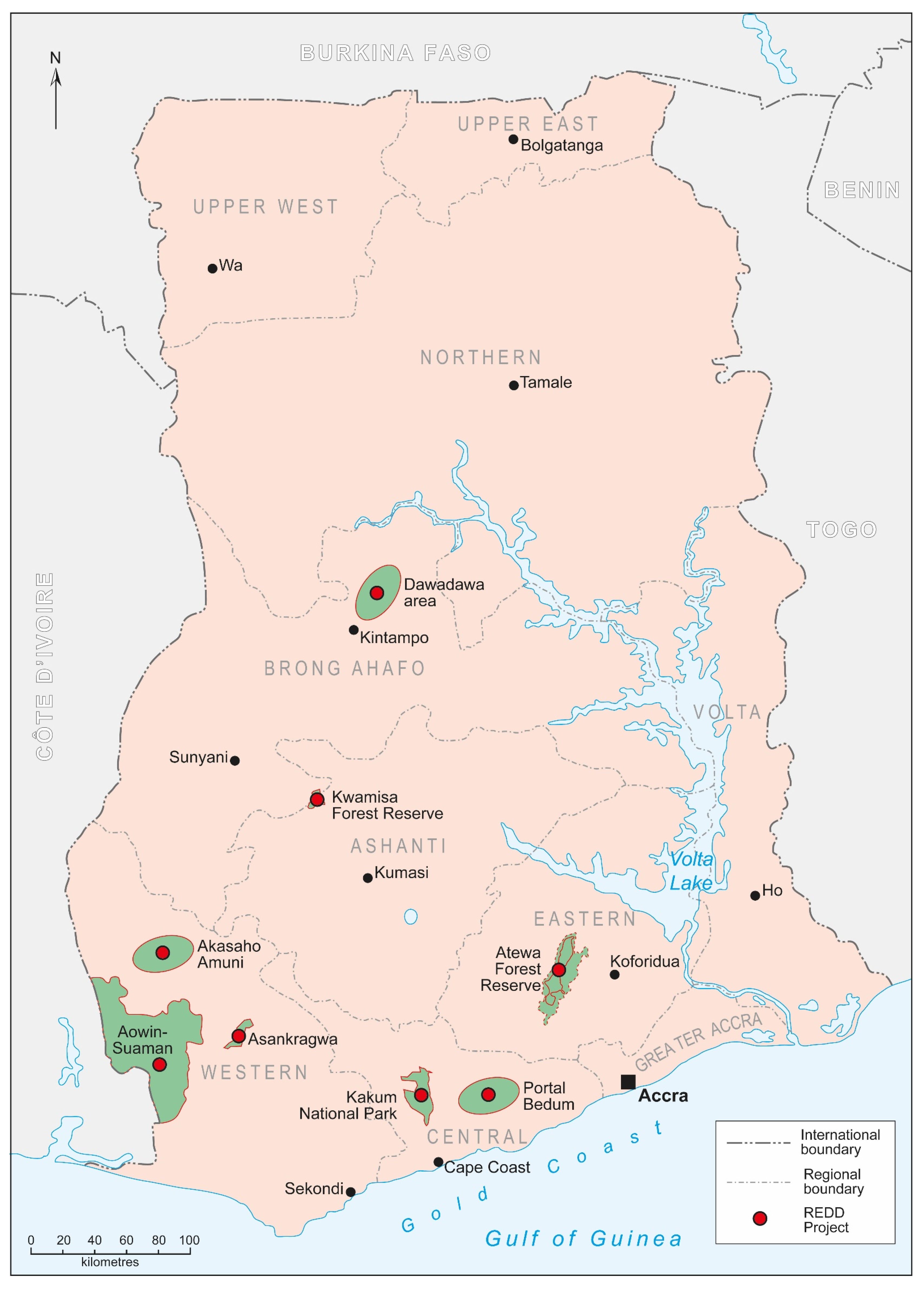
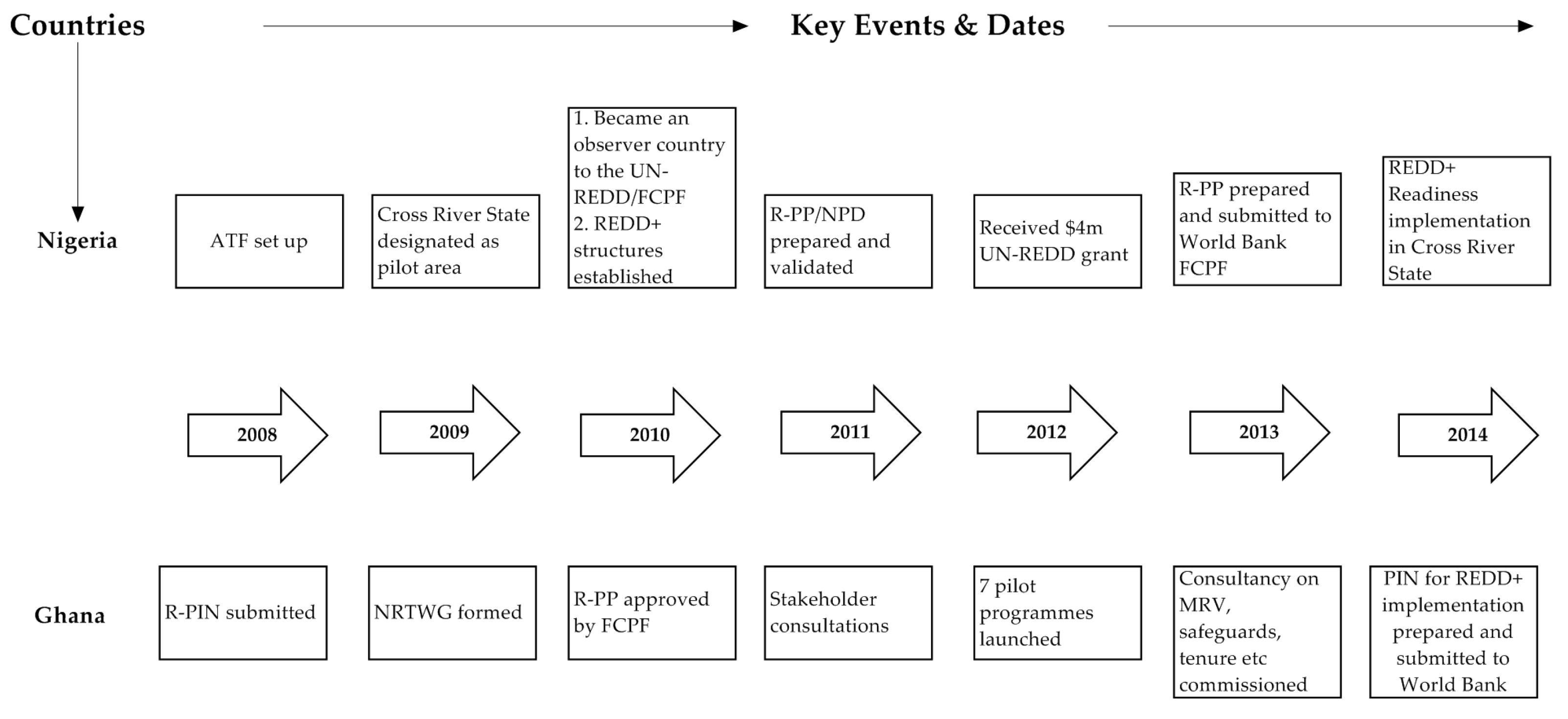
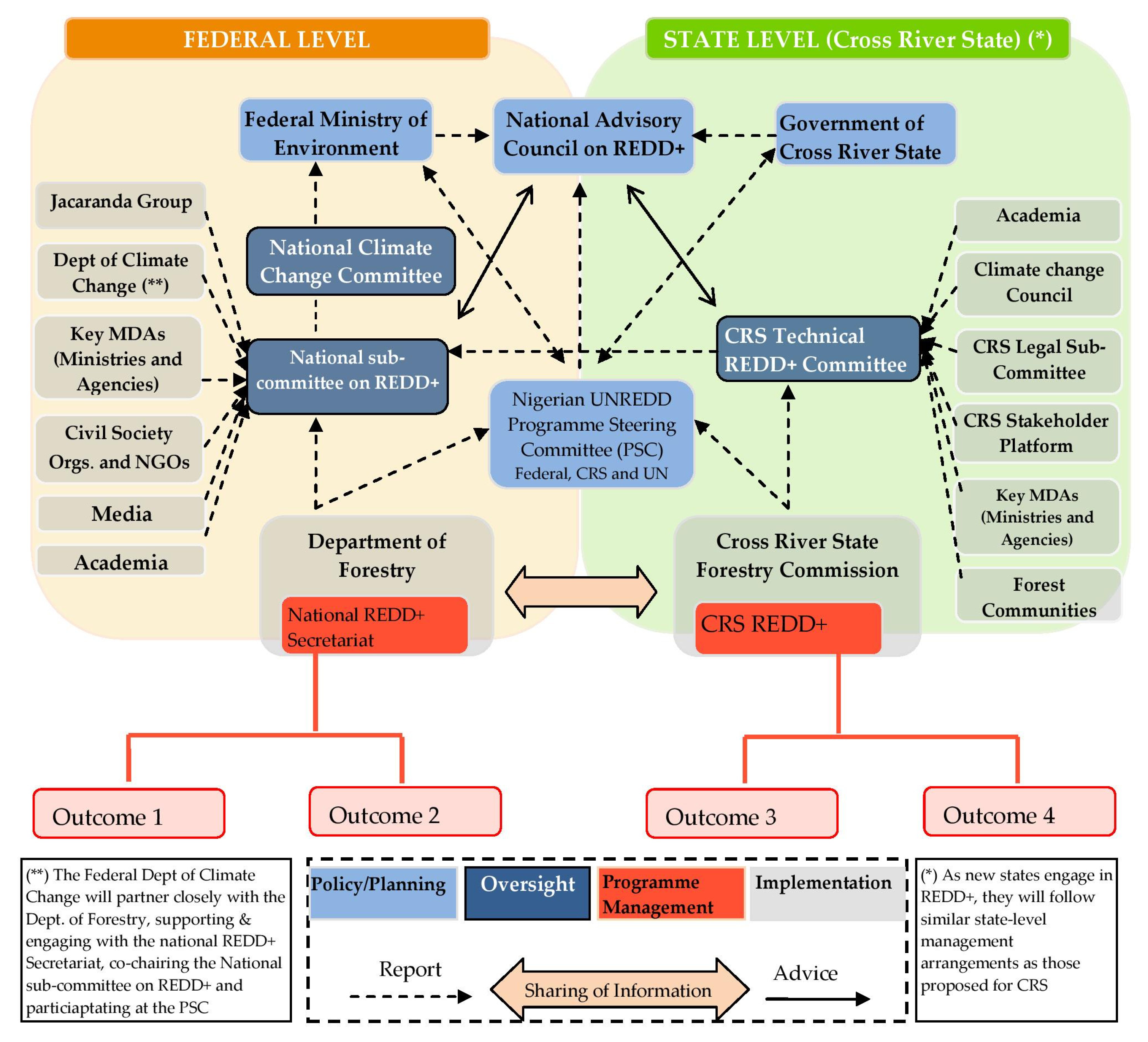
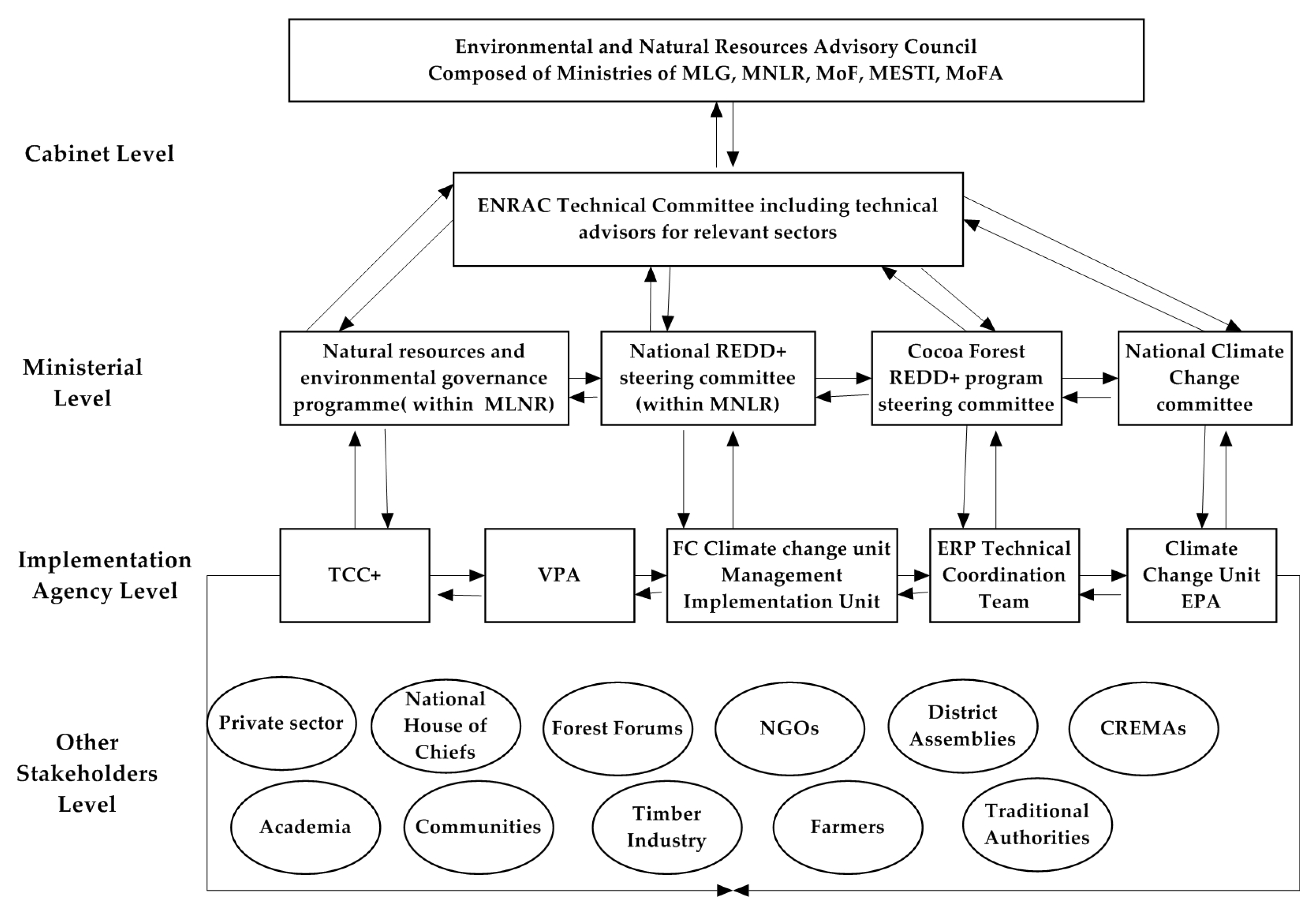
| Design/Implementation Elements | Ghana | Nigeria |
|---|---|---|
| Scale of REDD+ planning | National accounting with an ecological landscape approach to implementation | National and sub-national (state) implementation |
| Basis for nesting | Ecologically driven, based on zoning of the landscape and unique drivers of deforestation | Politically driven, based on pre-existing federal structure and the power differentials between federal and state control of land and forests |
| Total area | 8 million hectares spread across five administrative regions. | 14.4 million hectares in Cross River State |
| Institutional arrangement | Design based on a multi-stakeholder principle that situates actors across national, operational and local levels | Design based on the “all-affected”/multi-stakeholder principle |
| Land, forest and carbon tenure | Forest is owned by communities, but the National Forestry Commission holds the rights to manage forests. Dtermination of carbon tenure ongoing | The state governor in each state holds land in trust for the people. Therefore, there is a formal state trusteeship over land and an overlapping customary ownership. Carbon ownership claims are still indeterminate, but there are indications of state control over how carbon rights might be distributed |
| Implementing agency | National—The Ghana Forestry Commission | National—National REDD+ Secretariat Sub-national—Cross River State REDD+ Unit in the State Forestry Commission |
| Landscapes/ecosystems under focus | Rainforest, Agricultural land (Cocoa farm) | Rainforest; Mangrove |
| Securing forest property for REDD+ | Through negotiations with cocoa farmers (in agricultural lands) and through protection of existing state Protected Areas | Through state-wide forest protection (a logging moratorium) |
| Funding Allocation | Approximately $100 million committed between 2009 and 2014 although actual disbursement stands at about $30 million | A sum of US$4.2 million from UN-REDD; $3.6 million from FCPF; and $132,000 from Green Climate Fund; $466,000 from Small Grants Programme |
| Expansion | To be expanded into transition and northern savannah zones | To be expanded to other Nigerian states |
| Stated drivers of Deforestation | Agricultural expansion, illegal logging, fuelwood harvesting, mining, infrastructure development | Agriculture, state timber policies, mining, and infrastructural development |
© 2017 by the authors. Licensee MDPI, Basel, Switzerland. This article is an open access article distributed under the terms and conditions of the Creative Commons Attribution (CC BY) license ( http://creativecommons.org/licenses/by/4.0/).
Share and Cite
Asiyanbi, A.P.; Arhin, A.A.; Isyaku, U. REDD+ in West Africa: Politics of Design and Implementation in Ghana and Nigeria. Forests 2017, 8, 78. https://doi.org/10.3390/f8030078
Asiyanbi AP, Arhin AA, Isyaku U. REDD+ in West Africa: Politics of Design and Implementation in Ghana and Nigeria. Forests. 2017; 8(3):78. https://doi.org/10.3390/f8030078
Chicago/Turabian StyleAsiyanbi, Adeniyi P., Albert A. Arhin, and Usman Isyaku. 2017. "REDD+ in West Africa: Politics of Design and Implementation in Ghana and Nigeria" Forests 8, no. 3: 78. https://doi.org/10.3390/f8030078





